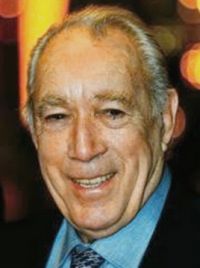Anthony Quinn
From Wikipedia, the free encyclopedia
Anthony Quinn (April 21, 1915 - June 3, 2001) was a Mexican-American actor, painter, and writer. He is best known for his performances in the popular Hollywood movies Zorba the Greek and Viva Zapata.
Early life
He was born Antonio Rudolfo Oaxaca Quinn in Chihuahua, Chihuahua, Mexico to an Irish-Mexican father and a Mexican mother, a combination that would later allow him to play many different ethnicities. He grew up in the Boyle Heights neighborhood of Los Angeles, California. Quinn left school early (much later, he received his first high school diploma from Tucson High School in Tucson, Arizona in the 1990s), and was a prizefighter and a painter before becoming an actor.
Acting
Quinn launched his film career playing character roles in several 1936 films, including Parole (his debut) and The Milky Way, after a brief stint in the theater. Quinn remained relegated to playing "ethnic" villains in Paramount films through the 1940s. By 1947, he was a veteran of over 50 films and had played everything from Indians, Mafia dons, Hawaiian chiefs, Chinese guerrillas, and comical Arab sheiks, but he was still not a major star. So he returned to the theater, where for three years he found success on Broadway in such roles as Stanley Kowalski in A Streetcar Named Desire.
Upon his return to the screen in the early 1950s, Quinn was cast in a series of B-adventures like Mask of the Avenger (1951). He got one of his big breaks playing opposite Marlon Brando in Elia Kazan's Viva Zapata! (1952).
His supporting role as Zapata's brother won Quinn his first Oscar and after that, Quinn was given larger roles in a variety of features.
He went to Italy in 1953 and appeared in several films, turning in one of his best performances as a dim-witted, thuggish, and volatile strongman in Federico Fellini's La Strada, having as his main partner the Italian actress Giulietta Masina (1954).
Quinn won his second Best Supporting Actor Oscar portraying the painter Gauguin in Vincente Minnelli's Lust for Life (1956). The following year, he received another Oscar nomination for George Cukor's Wild is the Wind.
During the 1950s, Quinn specialized in tough, macho roles, but as the decade ended, he allowed his age to show. His formerly trim physique filled out, his hair grayed, and his once smooth, swarthy face weathered into an appealing series of crags and crinkles.
His careworn demeanor made him a convincing Greek resistance fighter in the war film The Guns of Navarone (1961), an ideal ex-boxer in Requiem for a Heavyweight and a natural for the role of Auda ibu Tayi in Lawrence of Arabia (both 1962). The success of Zorba the Greek in 1964 was the high water mark of Quinn's career during the '60s - it offered him another Oscar nomination -.
He also started in the title role of John Fowles' The Magus. As the decade progressed, the quality of his film work noticeably diminished, though there were some successes such as The Secret of Santa Vittoria (1969).
The 1970s offered little change and Quinn became known as a ham, albeit a well-respected one. In 1971, he starred in the short-lived television drama Man in the City.
In 1977, He starred in the movie Mohammad, Messenger of God (aka The Message) about the origin of Islam, and the message of prophet Mohammad.
His subsequent television appearances were sporadic (among them Jesus of Nazareth).
In 1980 he starred in The Lion of the Desert movie, together with Irene Papas, Oliver Reed, Rod Steiger and John Gielgud. It was about the real-life Bedouin leader Omar Mukhtar (Quinn) who fought Mussolini's Italian troops in the deserts of Libya. The movie (which was produced and directed by late Moustapha Akkad) is now critically acclaimed after initially receiving negative publicity in the West for being partially funded by Libya's Muammar al-Qaddafi, thus its relatively poor performance at the box office.
In 1983 he revisited his most famous characterization when he played in a successful revival of Kander and Ebb's musical version of Zorba, which ran at the Broadway Theatre in New York for 362 performances.
In 1994, he became a semi-regular guest (playing Zeus) on the syndicated Hercules series. Though his film career slowed considerably during the 1990s, Quinn continued to work steadily, appearing in films as diverse as Jungle Fever (1991), Last Action Hero (1993), and A Walk in the Clouds (1995).
Shortly after completing his final film role in Avenging Angelo (2001), Anthony Quinn died of respiratory failure while suffering from terminal throat cancer at the age of 86 in Bristol, Rhode Island, where he had lived out the twilight of his life and is buried today in a family cemetery plot. His funeral service was held in a Baptist church; he had come to belong to the Four Square evangelical Christian community.
Family
Quinn proved as volatile and passionate as his screen persona in his personal life. He divorced his wife Katherine, with whom he had three children, in 1956. The following year he embarked on a tempestuous thirty-one-year marriage to costume designer Iolanda Quinn. The union crumbled in 1993 when Quinn had an affair with his secretary that resulted in a baby; the two shared a second child in 1996. In total, Quinn fathered thirteen children, among them Alex A. Quinn, Francesco Quinn, Lorenzo Quinn, and Valentina Quinn, and had three known mistresses.
Painting and Writing
Quinn was a student and friend of Frank Lloyd Wright.
In his free time, when he wasn't acting, Quinn continued to paint and became a well-known artist.
Anthony Quinn wrote and co-wrote two memoirs, The Original Sin (1972) and One Man Tango (1997). In the latter, Quinn is candid and apologetic about some of his past's darker moments.
http://en.wikipedia.org/wiki/Anthony_Quinn





